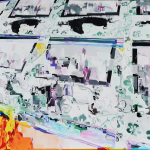BY DAVID RAMBO
1. Time’s Error
Welcome to the world of images—or, just as well, the image of the world. Such is Henri Bergson’s term for the thing in itself and for all its relations. Thus in his book Matter and Memory, he calls the universe the “aggregate of images.” To move entails a seamless transition of which any intermediary and end points represent mathematical abstractions of space mapped onto real material duration. Gilles Deleuze, in his writing on cinema, follows Bergson in calling these movement-images (Cinema 1 11). Film designates for its images the screen as a center within the world (10). A film consists of arbitrarily abstracted “immobile” or “instantaneous images” that represent time subordinated to movement. Deleuze argues that cinema portrays these images in their concrete duration. But in order to do so, it must designate for its images the screen as a center within the “whole” or world which is open to the enduring flux of relations. By the same token, the spectator’s body is a “living image” that serves as its own center according to which it “frames” the innumerable external images by parsing and reflecting them upon itself as, for example, a perception-image (62-63). Simply conceived, the body is a self-oriented system of reactions contingent upon the images it frames. Thus, while the cinematic aesthetic foregrounds the various movement-images through its own act of framing, viewers in turn reflect these images within their own frame of access.
Movement-images presented in film accord with the viewer’s sensorimotor schema that guides the framing of images and consequent bodily reactions. Thus, these images show time passing in subordination to movement. Obversely, what Deleuze terms the time-image depicts the work of time as such by breaking with or stunting the sensorimotor schema by way of irrational cuts, false continuity, absent movement, or the co-presence of variable pasts. In order to represent time in a “direct,” pure state to which “aberrant movements” relate, the image “[frees] itself from sensory-motor links” (Deleuze, Cinema 2 41, 23). In a scene from David Lynch’s Blue Velvet (1986), the yellow man, having been shot in the head, nevertheless remains standing (see Figure 1). Besides his barely noticeable swaying, the scene is a still shot of time unhinged from movement and into which the protagonist stumbles. As an interstice, the time-image provides a simultaneous before and after separate from the adjacent cinematic images, unique to and contained within only that interstice: a center adrift in its own indeterminate time (39).
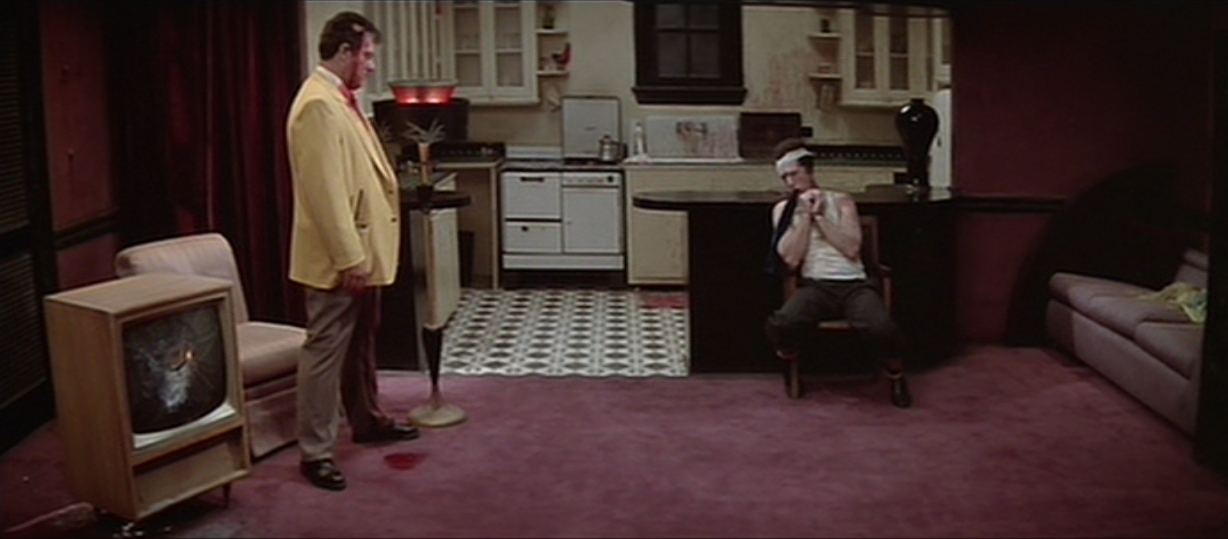
Deleuze delineates an abundance of time-images, each with their own principled temporality. For example, in an “irrational cut,” the interstice does not determine any commensurability, “there are only relinkages subject to the cut, instead of cuts subject to the linkage” (213-14). This abruptly diverts the spectator’s anticipation of the future and rather catalyzes thought into its own autonomous stitching of contiguity. On either side of the interstice there may be sensorimotor embodiment in the viewer, but the transition from one to the next lacks a connection appropriate to anticipated movements. Christopher Nolan’s Memento (2000) clearly exemplifies the irrational cut. Leonard, the protagonist whose post-trauma short-term memory loss limits his consciously accessible retention to the past eight minutes, seeks his wife’s killer with the help of notes and tattoos (see Figure 2, below). Each scene lasts eight minutes and ends with Leonard suddenly realizing he has forgotten that which took place in the scene’s opening. Nolan orders these sequences into a reverse narrative such that each scene’s end links up to the beginning of the previous scene. Another narrative interspersed throughout the film’s primary series of temporal steps shows a phone interview with Leonard who recounts a job he had prior to his injury. Thus, in addition to interstices organized according to reverse chronology, we also have a broader interstice that divides a past from the main sequence, both trapped in its own time as well as present in each and every eight-minute movement-image: the work of time borne by light, framed by screen.
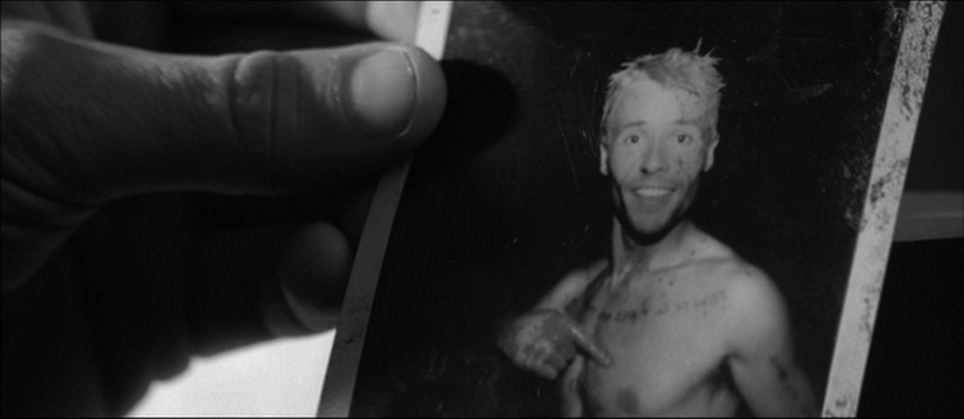
Yet Deleuze does not consider that in order to be understood as time “out of joint” from movement, the time-image must be framed and re-imaged by the viewer who is bound by the body’s indirect representation of time. That is, the time-image must be abstracted, reconstructed, re-imaged by the viewer who continues to be bound to the body’s indirect representation of time. Deleuze admits as much when he calls for an “analytic of the image” by which to read these various signs, but he leaves unexplored the process wherein the living image reflects a separate frame (Cinema 2 245). The time-image therefore remains a cinematographic image framed by cinema’s technics of selection, and for it to be taken up by the spectator would introduce a distinct regime of relinkages subject first to the interstice but also to the brain’s own technics of calculation and retention grounded in the material substrate of its memory. Memento’s interstices convey in one way how the time-image relies on the spectator to instantiate its temporal embodiment. As the film’s reverse chronology unfolds, the spectator reticulates within memory a continuity conforming to normative sensorimotor schemata. However, our question lies not in how the time-image operates as an aesthetic, but in the image that results when we try to make sense of the time-image while simultaneously experiencing the passing actuality of time as we do so. This is the error-image: a movement of thought whose anticipatory protention lacks any subsequent retention and therefore cycles forward unresolved, left to the throes of memory’s unconscious expanse.
As my terminology suggests, a brief look into Husserlian phenomenology provides a stepping stone towards a theory of the error-image. Consciousness persists through time by straddling the present’s divide: a retention of the past prolonged coincides with a protention that anticipates that which is yet to come. Bernard Stiegler, to whom we will return later, notes that in the flux of experience protentions compound with perception and cycle back as more or less accurately realized retentions, a process which “brings about the selection of new protentions” (Technics and Time 2 231). This is an economy of possibility carried by memory’s tests of consistency. However, a time-image radically denies the realization of such an anticipatory schema. I suggest that in an attempt to make sense of this image, the spectator’s retention-protention schema becomes entangled in a sort of technical jam in which conscious temporality is severed from external stimuli and thought unsuccessfully seeks a proper ground for bodily response. The time-image onscreen breaks the recursive link between protention and retention, setting off the error-image which implodes into a spiral or explodes into an unstable flux. Only retentional finitude saves us from this unceasing calculation: time urges memory’s actualization into the future, we register some affect and forget the problem posed by error, suppressing it into the unconscious.
The error-image can play out as a panic attack which forces a lapse of consciousness by over-inflating it with anticipatory calculation. Or retentional finitude can dislodge the circuit of memory in a number of ways. Let us first work through an example that directly exhibits the incipient components of error where the time-image merely instigates them.
Consider “Celery Man,” a digital short starring Paul Rudd taken from The Tim and Eric Awesome Show, Great Job. Paul is running a computer program which shows several costumed versions of himself dancing to synthesized music. Upon trying a new beta version, the erratic overload occurs (1:41). In the final sequence of the flux, all the windows exhibit the same looping few frames of Paul’s costumed personas. With “Celery Man” we have a representation of the experiential error-image (see Figure 3).
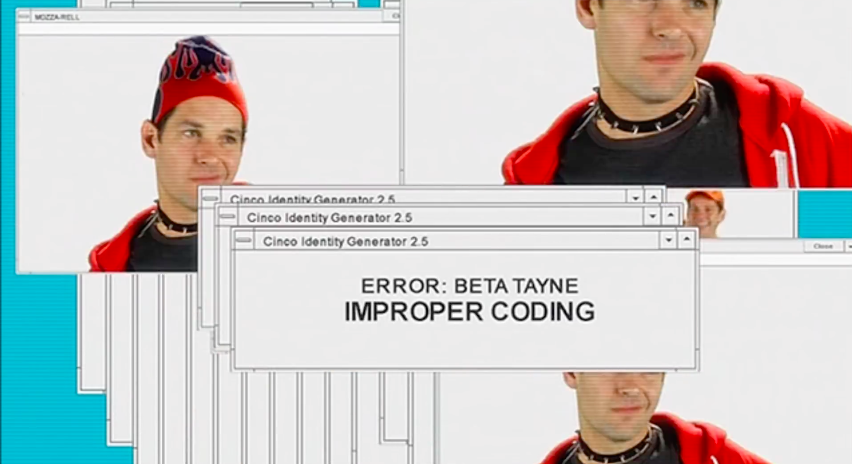
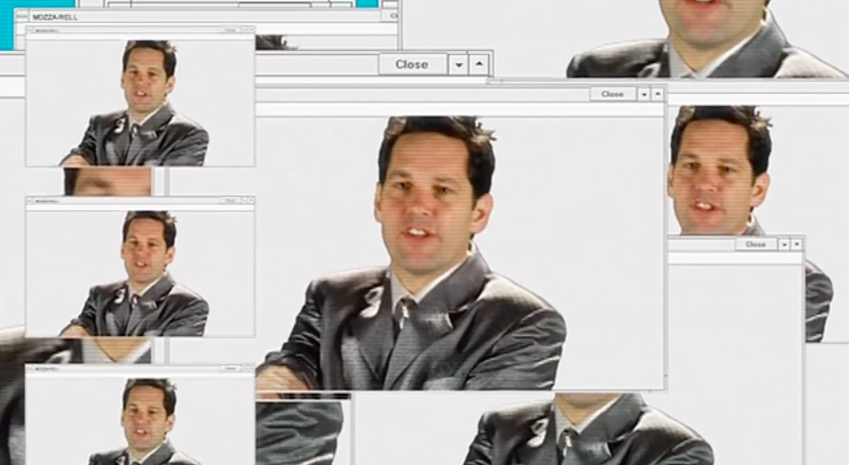
This manifestation of error on the screen’s GUI should not be termed digital, but visual. A properly digital image—to extend Bergson’s cosmology of images now—demarcates the computation of transistor relays: a looped section of code and machinic voltages which crash during runtime, for example. We can hear the error-image, too, in the frantic repetition of a splice of sound. Such audial effects have become prevalent in contemporary music, functioning as a single beat bridge between a song’s melodies. Guitarists of the so-called “math rock” genre, known for complicated time signatures and abrupt changes in melody, often stomp on a delay pedal for this digitally inscribed tonality of the in-between-note. Even more indicative of error is the way the sound effect feeds back by repeating its own additional notes, thus precipitating an interstice with increased volume and decreased delay between the notes. By momentarily jamming one’s expected temporal flow, the musical error-image affects the listener with the suspense of solutionless calculation. A retention dislocated from its expected protention primes the listener for an imminent pleasure realized by the song’s subsequent transcendence of error: a novel mode of discordant musicality invested in temporal, rather than merely tonal, dissonance.
Beyond its theoretical importance as an intervention into Gilles Deleuze’s Bergsonist theory of cinema and Bernard Stiegler’s technological phenomenology, the error-image also serves to focalize recent developments in time-based media. Of interest to us here is how the error-image’s embodied reframing of the intra-cinematic time-image resonates with post-cinema’s expansion of medial interventions into the constitution of perception. Though a reinvestment in the spectator’s body gives rise to the error-image in response to a time-image, our investigation into technics and memory will open this attention to embodiment from a human perspective to a more inclusive, generalized scope. In this way, a theorization of error’s plurality of images in both media-philosophical and aesthetic contexts can contribute to what Shane Denson has characterized as the “discorrelation” of images’ production from the human’s phenomenological standards.[1] In the same way that the error-image foregrounds the time-image’s latent rupture from any direct human perspective, so too do post-cinematic techniques realize and intensify the cinema’s capacity for radically altering the foundation of worldly experience.
2. Towards a Spiritless Memory
In addition to the temporal blockage that characterizes this initial look, the error-image implicates a wider framework of memory. Beneath the error, a latent weave of memory traces fills the time-image’s interstice and holds aloft the movement of thought as its substrate, the already-there horizon for the not yet: the virtual.
Temporalization
First, some terms. Conscious temporality refers to the perception of time, which expands physical time’s passing present into an experienced now. Sensation refers to a perturbation of physiological senses that takes place beneath the threshold of conscious perceptual awareness. Body and mind, unconsciousness and consciousness, exist as dynamic, processual relations within the material universe and physical real time. Experience of them remains confined to temporality.
Given the temporal difference between physical processes, bodily sensibility, and perceptual temporality, conscious presence must therefore be composed of already passed material interactions. Registering a past requires a retention, which refers to a form maintained through time. Any recording, whether a technical trace like writing or a physiological mark like a scar or a neural pathway, is a retention. Memory’s content furnishes our conscious temporality by informing us, via its own immanent and present retention, of the past as the present passes. Martin Hägglund explains the consequences of temporalization in terms of retention and protention:
these functions testify to the constitutive deferral and delay of différance. The delay is marked by the retentional awareness of being too late (in relation to what is no longer), while the deferral is marked by the protentional awareness of being too early (in relation to what is not yet) . . . I can appear to myself only by holding onto myself through retention and anticipating myself through protention.[2] (Hägglund 70)
Due to the necessities of its very existence, consciousness must have at least some immediate constitutive association with memory. The retention-protention schema substantiates a basic ground for conscious experience as an extra-present flux, but it alone does not definitively place memory’s cosmological entirety at the base of all conscious phenomena.
Neuroscience of Recollection
Example one. In his book Proust Was a Neuroscientist, Jonah Lehrer recounts working in Nobel Prize-winning scientist Eric Kandel’s lab at NYU. In his popularized account of Drs. Kandel and Kausik Si’s experiments with rats conditioned to fear a specific sound, Lehrer explains how blocking the proteins necessary to make new memories inhibited “the process of remembering a memory” (Lehrer 84-85). Not only did the rats lack fearful sensations, they also lost the “original memory trace,” which became evident after the protein blocker left the rats’ bodies. A class of proteins called prions, which are both resistant to decay over time and malleable without genetic material, enable memories to persist until enacted in recollection. A memory trace for recollection exists in its recall during the process of sensation, and its subsequent retention after recall memorizes the latest sensation in lieu of the previous. This process, called “reconsolidation,” follows Derrida’s logic of the trace, which affords a retention with material persistence by its being open to destructive differentiation. Indeed, according to the Hebbian theory of learning, the entire nervous system develops by adjusting activated synaptic weights, or the release of neurotransmitters, in proportion to their previous weights (Churchland 157-159). Sensibility thus sharpens its receptivity to the environment in a coincidence of reading and writing sensed bodily perturbations.
One more example. Neuropsychologist V. S. Ramachandran of the University of California, San Diego, complements these discoveries of memory in his work on neurological disorders. In the Capgras delusion, a patient cannot recognize an acquaintance’s face because a head trauma or brain lesion has severed the neural connection between the fusiform gyrus, which processes visual information from words to faces, and the limbic system, a region responsible for emotion (Hirstein and Ramachandran). Sensation of a seemingly single sense perception thus requires an affective tonality retained by memory and imbued onto perception as a concomitant recollection. Yet the patient still recognizes voices, suggesting that the auditory centers of the brain have their own neural pathways to the limbic system. Bergson also accounts for these phenomena precisely. He determines that unconscious association precedes recognition, and that any conscious awareness of association results from thought’s dissociation of the components present within recognition (Bergson 165). By the same token, “the alleged destruction of memories by an injury to the brain is but a break in the continuous progress by which they actualize themselves” (126).
Virtual Without Spirit
This minor sampling of contemporary neuroscience suggests that physiological memory combines a deconstructive trace structure with Bergson’s paradigm of memory: experience is produced as memory reads its retentions by re-writing them. We can now express the differences between memory, perception, and consciousness in terms of the actual and the virtual. “Pure memory consists” in a “virtual state” of all its latent potential (Bergson 239-40). Sensation drives an image through memory “in a progression from the past to the present . . . through a series of different planes of consciousness” that imbue it with the past, making it a recollection in a conscious “actual” state. This cerebral movement accords with Bergson’s cone, wherein horizontal planes represent various associative pathways of memory traces. The most expanded plane corresponds to the nonconscious, absolutely unresolved totality of bodily retentions, while the cone’s point is the most contracted state representative of “sensori-motor mechanisms” in action at a duration subliminal to perception, thus keeping it at the level of bodily affect (162).
Bergsonian memory entertains two instances of the actual and the virtual. One equates memory’s retentional apparatus of the past maintained in the passing present to the virtual, the reading of that virtual to actualization, and the resultant conscious sensation to the actual. Another has the actual perception-image prehended by the body collide with the virtual memory-image selected for association, thus providing experience with a recollection-image indissociably composed of both actual and virtual elements. The cone represents the unconscious potential for memory’s actualization into consciousness, not the possibilities for a variety of conscious states. Each plane, including the contracted point of present consciousness, contains the entirety of the past because the untraced retentions rest latent as memory-images, their exclusion from consciousness not an erasure from the real, but a necessary measure of contraction’s finitude. As it passes, embodied sensation and conscious perception subsist on all of memory, whose virtual state in relation to consciousness takes the form of pre-incipient potential for actualizing contamination.
The cone, of course, is but a heuristic that Bergson employs in tandem with his didactic divison between pure perception, or durationless matter, and pure memory, or absolutely unactualized spirit. At the cone’s point lies the plane of pure perception. Its most expanded plane partakes in, but still does not equal, pure memory. Bergson refers to pure memory as “the domain of the spirit,” while also securing the selections constitutive of human freedom to an image of matter, the memory-image, or rather the collection of such in a body (240). That he retains this immaterial term despite merging matter and spirit is a consequence of the ontological principle of duration. As real qualitative movement, duration must both repeat the entirety of the past, which is the ground for sensible qualities, and enact the thickness of the present in all its multifold contractions of that repeated past (202, 246-47). Without dualism, Bergson’s cosmology would devolve into either static pure perception or unactualized, immaterial spirit of pure memory. Duration, we could say, is the and between Matter and Memory.
Contrary to Bergson’s insistence on a dualism of material perception and immaterial spirit, the virtual must denote dormant potential in real, material relations. “Spiritual” does not refer to any transcendental property, only a residual image that enables some array of actions in response to perception. Memory is spiritual only because it adds to stimuli as the body perceives them, saturating perception with the past retained by memory. This actualizing recollection which conditions memory by prompting its “reconsolidation” is the mechanism of the virtual’s survival through time, the multiplication of a living image’s sheets of past (Lehrer 85). Memory’s inability to revitalize past retentions without inextricably altering them shuts down what Deleuze calls “spiritual repetition,” which is the repetition of the past for itself (Deleuze, Difference and Repetition 84). For the Deleuzean syntheses of time, the past in its unalterable coexistence repeats as a metaphysical requirement for time. But in order to convey this coexistence in terms of human memory, Deleuze turns to the very same example of reminiscence that Lehrer uses in his entirely material explanation of extratemporal memories awaiting recall: the involuntary memory of Combray that overcomes Proust upon tasting the madeleine.
3. Error as Interstice
Interstice of Co-Presence
Sensation collides with memory in a vortex of subjective indeterminacy; it is inescapable. No consciously lived present exists without memory’s constitutive temporality. No sensation comes to actual perception without memory’s virtual past. Another sort of time-image corresponds to this actual-virtual bifurcation, Deleuze’s “crystal-image,” which is an actual image “crystalliz[ing] with its own virtual image” (Deleuze, Cinema 2 68). Between the real and its mirror, we watch time pass as the real’s actual becomes virtual, and that virtual becomes actual in the mirror. In its actualization, the subjective becomes objective: a fleeting self bequeathed by memory in present circumstances more or less protracted. Actual and virtual are indiscernible because memory and sensation coalesce prior to perception, but they remain incompossible “because it is a perpetual self-distinguishing, a distinction in the process of being produced” (81-82). With the crystal Deleuze seeks to further enmesh Bergsonian philosophy into cinema, here showing our interiority to time by conveying time’s two-sidedness consisting of passing presents and retained pasts. Unlike the interstice of false continuity, the actual-virtual interstice layers within “the mutual image” sheets of past, which chronological time refuses to make co-present by the nature of the sheets’ own temporal creation and retention. At stake is the confrontation of the conscious “inside” with its underlying unconscious “outside” (207). Narratives with split personalities like David Fincher’s Fight Club and Darren Aronofsky’s Black Swan often make use of the crystal, the former with two different actors rapidly switching in and out of an image, and the latter with mirrors. Likewise, the presence of a ghost beyond the present of its death exhibits time’s work insofar as the past grounds the present. Two scenes from Michelangelo Antonioni’s The Passenger (1975), a film about one man’s theft of a dead man’s identity, will explore how this “mutual image” layers sheets of past, which chronological time cannot make properly co-present.
The spectator first witnesses David Robertson dead, face down. He is a set of clothes and the back of a head with brown hair. This shot is the first in which we see David Locke, played by Jack Nicholson, in the same space as Robertson. The flashback to their relationship is yet to come, and neither have we much sense of Locke’s own character. For the setting offers the only significant evidence of the film up to this point: wide open and featureless desert waiting to be furnished, what Deleuze would call an “any-space-whatever.” Antonioni thus presents Jack Nicholson’s process of becoming-actor in that he begins psychically stripped down, seeking an object that will reflect Locke’s constitutive image. This moment comes when Locke discovers Robertson dead, for Locke pauses, staring, aware of the death but stationed in a temporal limbo hinged on his decision to accept or to deny this death. His identity-theft does both.
We come to know Robertson only later, once Locke has assumed his persona. Thus to learn of Robertson’s identity is only to construct Locke’s. While their voices resound scratchily from a tape recorder to compose a distinct sound-image at first, David and David enter the camera’s visual shot through a window to a past present with the back of their heads facing the spectator (see Figures 4-6). Antonioni invites us to confuse these nearly identical heads of hair and to see them coalesce with the formless sand. While listening to the tape replaying that past, David Locke dons Robertson’s clothes in the present, which marks the first step in his self-identification as David Robertson. Through the window’s past present, we have no sure way of knowing which body breathes and speaks beneath the khaki pants and blue shirt or the brown pants and red plaid shirt. Locke’s voice we recognize as Jack Nicholson’s, but in this layered temporality that combines Locke-becoming-Robertson in one moment with Locke and Robertson in another, one out of frame and the other within, there can be no certainty that Locke’s voice has not already been disembodied—or more precisely, re-embodied—in the depiction of a supposedly past moment.
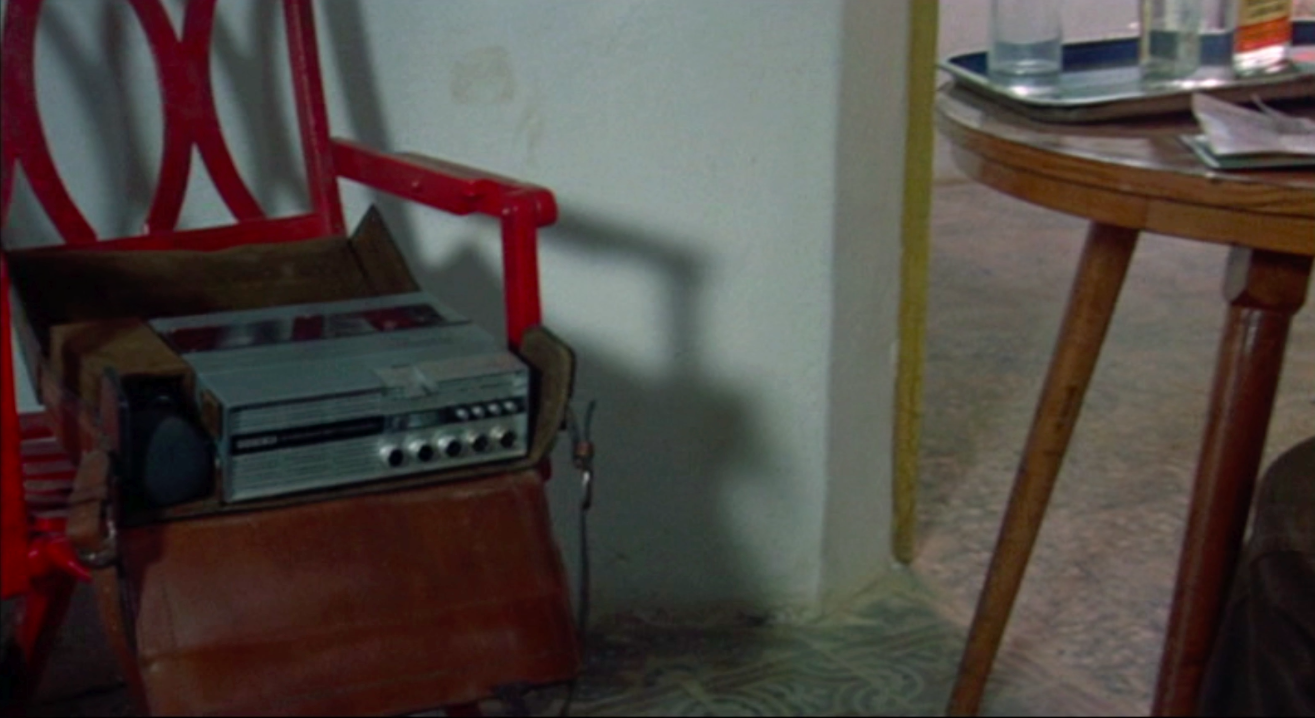
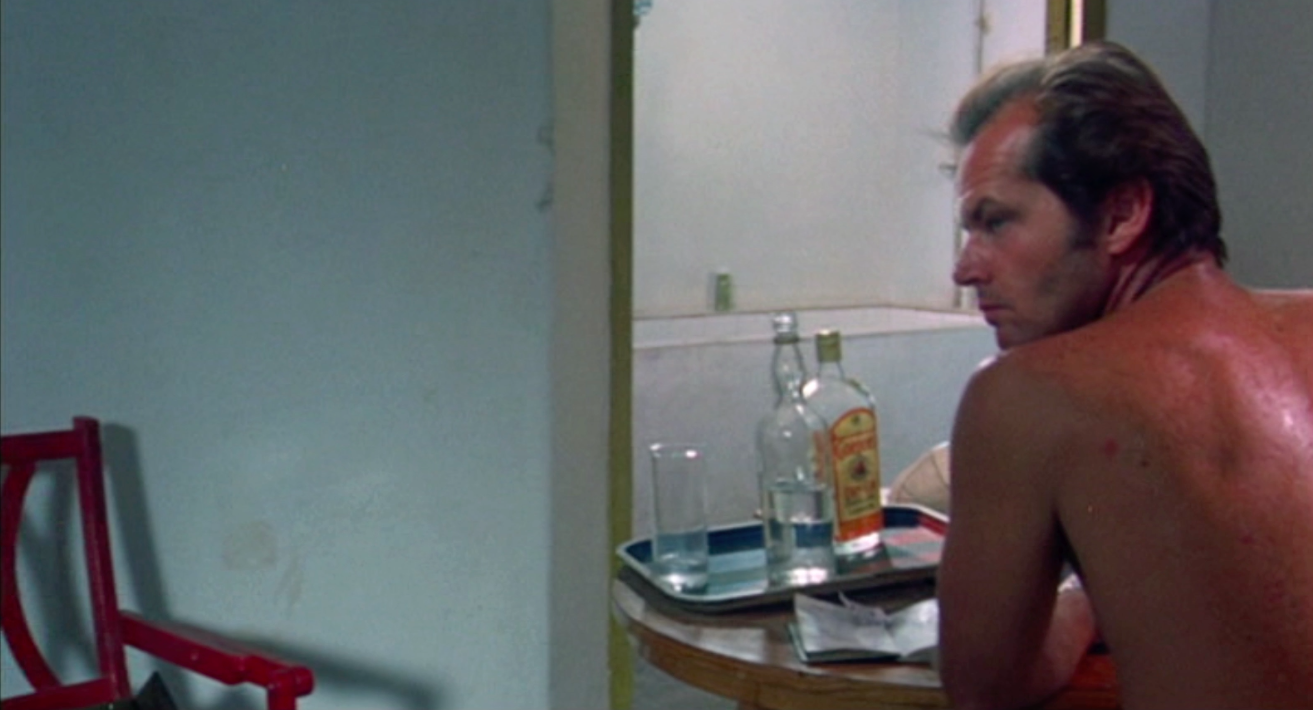
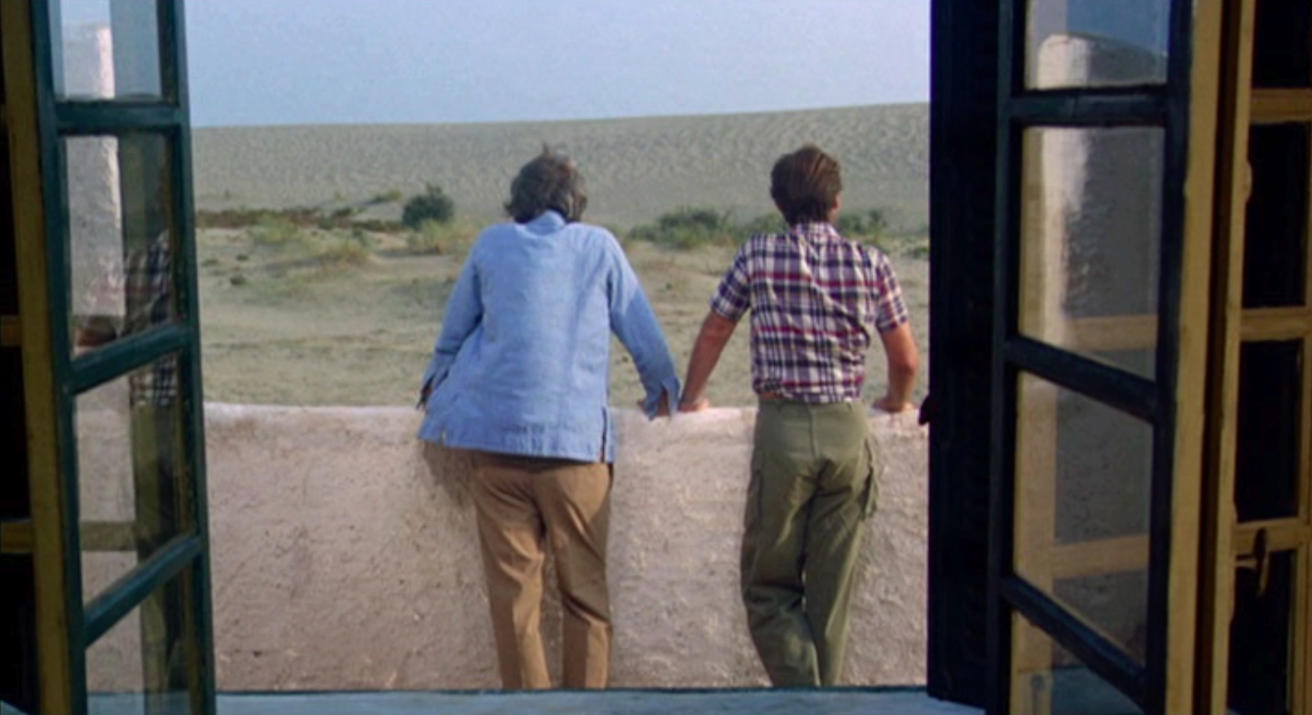
From Sheets to Stitching: Recapitulation of the Error-Image
Only by witnessing the conversation between Robertson and Locke after Robertson’s death do we understand what Locke sees as he pauses to watch Robertson’s dead body. He is passively seeing, while he actively creates the same entanglement the audience experiences through that window. No longer merely an irresolvable protention, the error-image within the spectator’s mind is one that opens thought to its material substrate and stitches contiguity among so many sheets of past according to the temporal dimensions provoked by the interstice. More forceful than the looped flux of aberrant movement is the error induced in the attempt to overcome the necessary impossibility for human memory’s (actualizing) inside and (virtual) outside to confront each other on equal terms. This is the error-image of the panic attack, its capacity to affect increasing with its duration as a recursive loop wherein the analog human faints or the digital machine, its allocated memory overburdened with repeating procedures, stalls and crashes. Such an error-image results, in this case, from a nascent version of the sort of techniques that characterize post-cinema: due to the classically cinematic smooth direction of the shot, the fluid juxtaposition of two different times actually reflects back on the camera’s, and the tape recorder’s, production of both the spectator’s and the character’s irrationally conjoined perceptions. The mediately forced inversion of actuality into its phenomenologically excluded virtual constitution speaks to the comparative madness of post-cinema’s “crazy cameras” (Denson). Inasmuch as the time-image, framed by Antonioni’s camera work, launches the spectator’s mind into error, it detaches the camera from its conventional diegetic procedures as a conduit for human perception and instead presents directly the perceptual efficacy of its technicity. In other words, an error-image has the potential to transfer attention from the object of cinematic presentation to the mediating processes of that presentation. The confrontation with a bit of time in its pure state can only result in the viewer’s confrontation with the materiality of time as a complex of temporalizations that mediate, not the object of perception, but the very event of perception.
Whereas the time-image conceptually signals a sort of cognitive dissonance wherein both actual and virtual are coalesced for perception, the virtuality of the error-image refers to the unactualized, latent memory that passed through thought as ambiguous, amorphously formed recollection-images. The time-image opens up thought to memory, from which it came, by unhinging time from movement; the error-image, as I am theorizing it here, explores an alternative middle ground in the movement of thought itself that seeks its virtual ground anterior to time’s subordination to material relation, with an end to undo conscious temporality’s technical and chronological conversion of, and therefore concealing of, “time in its pure state.” Likewise, a post-cinematic aesthetic tends to interrogate the multiply mediated creation of humanly perceivable sense by foregrounding the technics that escape phenomenological awareness. Instead of audiovisual representation, we witness a concatenation of data-based mediations. Just so, the error-image highlights the impossibility for human perception to come to terms with what it constitutively excludes—even though that which is excluded comes to play a primary role in the provision of sensible material for human perception.
Let us consider another example. Onomatomania refers to the frustrating inability to recall a word whose signification is known to fulfill an intended linguistic meaning. As the experienced obstruction of memory’s actualization in which sense cannot make the transition into language but only anticipate an intended recollection-image as the linguistic end, this is an error-image proper to human consciousness. The onomatomaniac cannot complete contraction’s recall, instead ceaselessly and unsuccessfully filling a conscious space with a vacuum. Like a pristinely polished neon sign devoid of electricity: we know it is there, but we cannot excite it with the electrical vibrations necessary to see it. But what does it mean to border on the recall of pure memory as such? Or in Deleuze’s appropriation of Bergson’s terminology: what does it mean to actualize the virtual without dispossessing it of its virtuality? An affirmation of such a radical destabilization of conscious temporality would problematically equate the first passive synthesis of time that subordinates time to movement through habitual repetition to the second passive synthesis, which is the coexistence of pasts.[3] Rather, an error-image necessitates the first synthesis’s feeling around in the unfamiliar expanses belonging to its temporal sibling. A blind groping for the sensed word shapes obtuse gestures that accord more or less to the retention that awaits, forming in the process a temporal-haptic space for the non-temporalized infinite excess of Time. In its manic fancy, the actualizing retention casts aside misfit language like the failed pile of letters in a game of hangman. Whether the onomatomaniac acquiesces to virtual memory’s indomitability by settling for an alternate word, or manages the proper pathways of recall, it is the pressure of futurity that drives the actual until its termination of the error through its transference as protention into retained memory.
The uniqueness of a theory of the error-image lies in the fact that it grafts onto the time-image its own flux of interpretation. With “dream” or “metaphor,” cinema tries to “integrate thought into the image”—“to bring the unconscious . . . to consciousness” (Deleuze, Cinema 2 160-1). This is all thought of the movement-image, whereas the time-image would collapse the cut between thought and action in lieu of a depiction of the time that enables thought to inform the action-image. But what of bringing consciousness to the unconscious? To the viewer, the time-image remains a sign representative of both actual recollection and virtual sheets of past. Only the error-image, in its attempt to fill the objective depiction of an absent ground for time, brings “the thinker” to the “presence to infinity of another thinker in the thinker” (168). Its aesthetic—in both senses of artistry and of sensibility—commandeers the standard perceptual ordering of experience and confronts it with the subperceptual constituents of that ordering.
4. Technics of Memory
How, then, are memory traces made? More precisely, how are they made, in the case of the error-image, to harbor that which ought to remain outside of their sensible range? How do they relate, collaborating in overlapping milieux and technical assemblages? Our discussion of human memory’s reconsolidation by recollection alluded to this problem, and here it extends into Bernard Stiegler’s incorporation of technics in Martin Heidegger’s existential analytic and Edmund Husserl’s phenomenology of time consciousness. According to the first volume of Stiegler’s Technics and Time, technics are “organized inorganic matter,” from language and writing techniques to tools and global networks (49). He proposes that, as “artificial memory supports” providing access to the already-there, technics marked the inception of a co-evolution with the human: one part exterior to the body called epiphylogenesis, the other the phylogenesis of the prefrontal cortex (159). Therein lies the human’s technical ontology: the foundation for a retention that awaits, the technique of anticipation, or protentional consciousness qua retentional facticity.
In Volume 2, Stiegler takes up Husserl’s phenomenology of time-consciousness and of the historical continuation of an intersubjective knowledge of idealities such as those constituted in mathematical research. Following Husserl, conscious perception in the present is termed primary retention (or memory), recollected memory is secondary retention (or memory proper), and technical retention exterior to human biology is tertiary memory (embodied in written records, audiovisual media, etc.). In his analysis of repeatedly listening to a recorded melody, Husserl determines that secondary memory conditions primary memory’s selection of what it retains for a short duration in the immediately passing present. Husserl misses, as Stiegler points out, how his recognition of recollection’s determination of conscious perception relies on the technical recording of the melody. This third stratum of exterior mnemotechnics is Stiegler’s addendum, and it brings technical supports to the center of intellectual labor. By contrast, Husserl relegates the “art and method” of symbolic notation and recording techniques to the role of “surrogative operational concepts” (Husserl 126). From the initial formulation of the phenomenological method in his Logical Investigations to the final manuscripts known as The Crisis of European Sciences and Transcendental Phenomenology, Husserl consistently links scientific knowledge, or knowledge of idealities, to concrete situations of purely human experience. By Husserl’s accounting, technical methods occlude this genesis of sense, such that the original intention of an ideality must be frequently reactivated by bracketing the extraneous “art and method” of technical surrogates and returning to its phenomenological genesis. Stiegler, however, argues for the reactivation of an ideality “sealed within” tertiary memory, and that “recovery is impossible, meaning that secondary memory penetrates into primary—except when tertiary memory is present” (Technics and Time 2, 229-30). He thus inverts the order of knowledge’s genesis by rooting the sense of intellectual labor in the techno-logical establishment of exact repetition. Tertiary memory dissolves the distinction between primary and secondary memories by sustaining an identical perception for conscious retrospection. Ultimately, Stiegler concludes that temporal objects such as film and audio recordings graft their flux directly onto the flux of consciousness, which entails an even more exact access to idealities than does writing (241).
Technics of Memory and Memory as World
According to Stiegler’s argument, the prefrontal cortex is the culmination of an interiorization of exterior technics and vice versa: self-reflective conscious experience is itself technically conditioned. Problematically, however, Stiegler’s belief that technical recording’s increasing exactitude circumvents secondary memory’s contamination of the Living Present would mean that primary consciousness as it passes in the present precedes its apperception, ergo its creation, in secondary retention. Secondary retention’s “criteria for selection,” as he phrases it, can become ultimately synchronized with those of the “programme industry’s” hyper-industrialized tertiary retentions, so that individual experience is increasingly crafted by and through the mass media.[4] Certainly, the who is a what, meaning that both human subjectivity and its objects are technical artifacts, but the technics of recording differs greatly between human memory and those of inorganic objects. To supplant consciousness’s actualization of virtual memory with that of tertiary retention requires the complete effacement of any human retention whatsoever by denying its specific, constitutive materiality. On the contrary, secondary memory takes in a tertiary retention as any other sensation-image and subjects it to its retained past of memory-images in order to compose perception in primary retention. By the same token, a technical object’s own technics affords its expansion of retentions and their persistence through time, subjecting incoming action-images to its own technological framing.
Human memory as genetic and neurophysiological inscriptions is incorporated in a differentiated genus of technics known as the who, or the human individual, whose historical engagement with exterior technical objects is only possible due to a common, undergirding technicity. Stiegler’s crucial insight is to have designated this technicity in the co-originary coup of who and what. But an anthropological and prosthetic conceit in his tripartite stratification of memories limits our conceptualization of technics. Despite radically expanding the scope of the Heideggerian thesis of being-in-the-world as a necessary condition for human being’s spatiality and temporality, Stiegler maintains both an overly cognitive bias in his critique as well as an entirely too distinct separation in human civilization between the technical system’s developmental tendency and the “bio-anthropo-logical” evolutionary tendency (Technics and Time 2, 7).[5] He comes extremely close to a more balanced realization of his deconstruction of the who/what binary, for instance, in this following passage from the third volume of Technics and Time:
being-in-the-world is a being-in-the-“mondo-historiality” of the memory of the world, ein in-der-Weltgeschichtlichkeit-sein, a being-the-world in which the world is the memory of objects and objects of memory, beyond the “complex tools” and “references”: a fabric of tertiary retentions that are the condition of primary and secondary retentions, as Being and Time indicates: they are possible, the existential analytic tells us, only through the facticity of an already-there. (161)
We see here one of Stiegler’s seminal critiques of phenomenology: that Heidegger ought to have included all manner of exterior, technical retentions or memory supports in his existential category of “world-historiality,” but which were on the contrary deemed “inauthentic” to Dasein’s being-in-the-world and therefore conducive to occluding rather than unveiling phenomena. Stiegler, however, unnecessarily continues to exclude those memorial associations with exterior non-technical objects or what we could simply call natural processes, which have their own regime of memory in the Bergsonist sense.
Instead, I locate the body of the who within, not a tertiary memory that is simply a what, but a transcendental field composed of, and in which subsist, appendages of memory only some of which are differentiated according to the work of technics. We may think of the world itself as an organizing field of memory contracting through technics and nontechnical, sedimented physicochemical processes. Memory as world is made necessary by time, and is thus synonymous with Derrida’s “arche-writing,” or what Hägglund refers to as the “ultra-transcendental” logic of temporalization (Hägglund 50-75). Time necessitates a present that is both already there and delayed in its becoming present, while its contents in space are in a continual flux of extra-present differentiation. The “aggregate of images” in Bergson becomes now the movement of pure memory through the durational present: a non-spiritualist virtual that brings the past to bear on the present as potential forces.
Return to Error
With its explorative relation to memory, the theory of the error-image provides an avenue to address, first, the issue of “re-commencing the flux” stored by tertiary memory, and second, that of contributing to its progress. Opposed to the error-image of onomatomania is the failed attempt to pick up the intended conclusion of a half-written sentence after losing a train of thought. In this instance consciousness has the sensation of a clearly defined recollection-image of having been involved in the (interrupted) process of smoothly writing out a formed sense and forming thought of words. Whereas an error fails to drive sense into language, this lost train is the senseless awareness of forgetting, like an intaglio submerged in a pool of ink. Nothing remains trapped between virtual and actual memories as in the error-image, which would be like the inking in of an intaglio partially sanded flat. Unlike error’s technical jam, the barrier of forgetting invites tertiary memory (as embodied in technical inscriptions) to serve as a perception-image that could prompt a memory-image coincidental with that lost flux to “return” to consciousness: a reminder in the remainder. One must not forget that, due to reconsolidation, human memory’s actualization of consciousness is an erasing renewal of retentions and thus immune to the reactivation of the same. The experienced relation between a temporal object’s flux and the flux of experience constitutes an interstice, a crystal-image between mind and screen, or mind and page. Therefore any addition to tertiary retention derives as much from the virtual past as from the actual perception. Text displayed by a computer monitor exhibits the same actual-virtual combination: the font’s symbolic regime collaborates with the writer’s technical manipulation of those symbols. Between a reader and a writer, the experience of those traces as recollection-images differs, and to the screen the retentions maintain their own distinct movement-images of matter. These sorts of conjunctional operations illustrate the functional differentiation of memory appendages as technical interlocutors equally participating in a field of memory assemblages.
Duncan Jones’s film Source Code (2011) combines human and computer into an error-image indicative of a collaborative dwelling. In the technical sense, to dwell refers to the “slight pause in the motion of a part of a machine,” which we get in the film as the restart of the eponymous program’s eight-minute simulation of a bombed commuter train (OED). For Captain Colter Stevens (played by Jake Gyllenhaal), dwelling takes on Heidegger’s sense of the word as a lingering by which “perception becomes definition” (Heidegger 61). “Source Code,” the film’s titular virtual reality program, provides the same initial scenario taken from the memory of one of the bomb victims on the train and modifies its in vitro ecology as Stevens reacts, these acts afforded by his compiled understanding over each successive attempt to identify the responsible culprit before a second bomb goes off in the real world. Program and human serve each other as exterior memory supports, always within the same cohesive past contracting in the present. Stevens also relies on further medial dwelling, for less than half of his body remains after what ought to have been a fatal helicopter crash in Afghanistan. With the “Source Code” program, a fragment of time itself has been condensed into image-form and stored as data for indefinite reproduction. Interestingly, this long form instance of the error-image collapses the diegetic/non-diegetic split, a distinction often undercut by post-cinema’s reflexive incorporation of the technical conditions of its own production. When we see Stevens’s self-representation in a spherical room-cum-helicopter-cockpit, this is clearly a diegetic representation for the audience as well. But when we look on the wall of hardware and monitoring devices that afford the military team access to Stevens’s computationally supported brain states, the diegesis collides with its own non-diegetic foundation in post-production special effects (see Figure 7, below). Here, the erring movement of thought takes on more than the stitching together of dissociated temporalities. It must come to grips with the gratuitous visuality made possible by the absence of the camera. If cinema’s most experientially intense problem for consciousness is pure time or duration, then post-cinema’s might very well be the other, non-temporal end of Bergson’s heuristic concepts from Matter and Memory: pure perception.
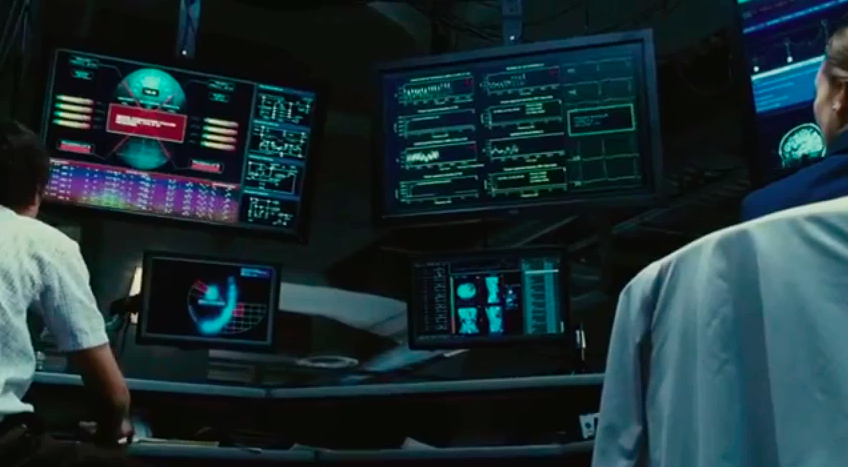
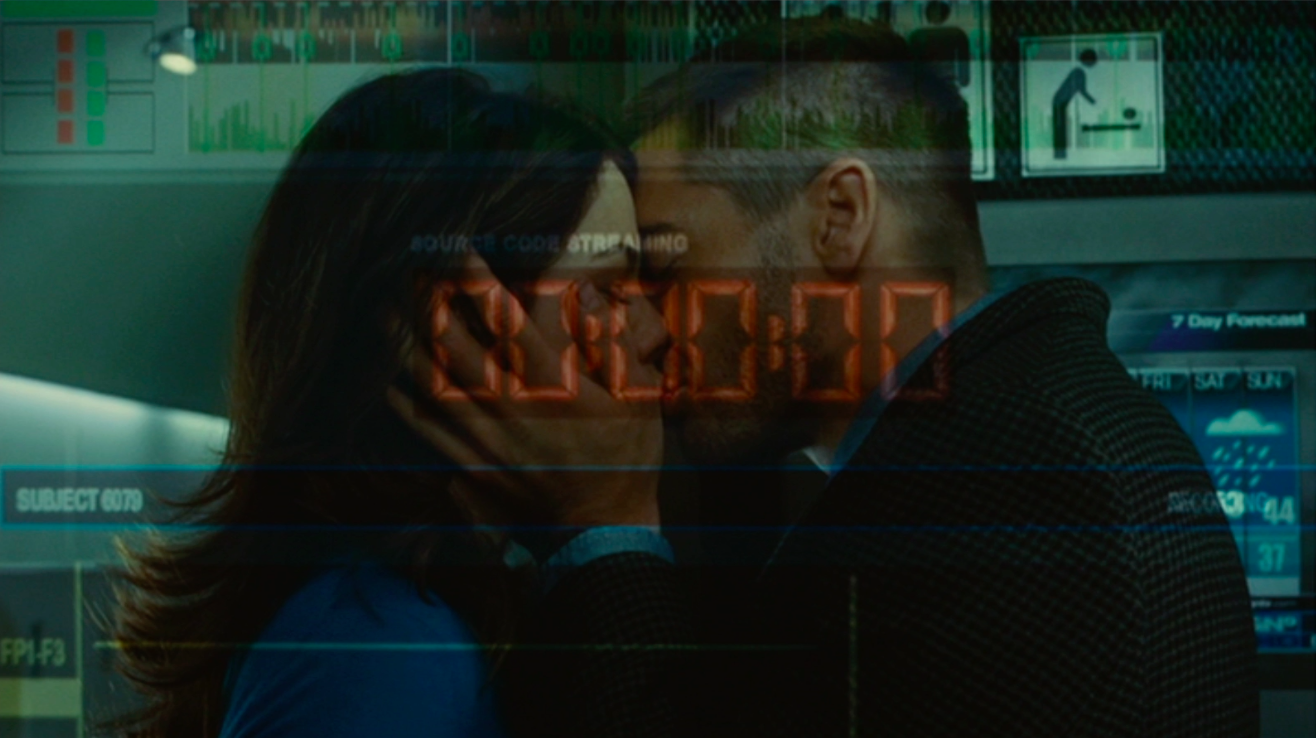
Ultimately, with the second bomb threat thwarted, Stevens returns to “Source Code,” which indicates that the error-image depicted by the film may not be the dwelling in tandem for a protention to link the simulation back into the real world where the terrorist continues to plant bombs. In the final run, the error-image precipitates a still time-image of the simulation at the moment Captain Stevens’s real body dies. Unlike the deaths he undergoes in the program, which reloop Stevens back into “Source Code,” the viewer watches this “real” death as a frozen frame of the coded reality, which is slowly revealed with increasing depth as the perspective floats backwards (see Figure 8, above). This directly invokes Bergson’s pure perception, or the totality of matter-images stricken from duration. It is ambiguous whether this sequence ought to be taken as its own time-image, removed as it is from the sensorimotor continuity of action flowing from perception, or as a perception-image without movement. In this single-frame shot, the cinematic image stalls, it defaults on its temporal promise of depicting real continuous movement, and delivers instead a post-cinematic fantasy of digital data made visual and given an artificial duration without concrete correspondence to physical events.
The visual presentation of a final image in death brings to bear the futural weight of mnemotechnically collaborative time onto the source code program’s mechanical dwelling. Of course, this is a Hollywood blockbuster, so instead of a final image in death, Source Code ends with a cosmogony by means of memory and a kiss. The “sourced” world takes on the infinite expanses of pure memory’s virtuality, redeems the Captain of his biological death by standing in as, to borrow Quintin Meillassoux’s phrase, a “creative death” wherein the inside explodes onto an outside that implodes to fill it up with an active response, and thus trips the standard post-dwelling swipe of “Source Code’s” memory by instantiating its own (Meillassoux 103-107). This signals the immanent virtualization of a distinct lobe of memory-world via its detachment from what used to transcend it and thereby contain it. Source Code ends with a mnemogony that conveys not two sheets of past in an interstice of co-presence, but an absence of interstice—for what cut could subordinate the relinkages of two entire cones within disparate Times?
When we began, the error-image erupted in response to a cinematographic time-image, while here we follow an error to its completion beyond the technocultural regime of cinema and receive yet another image of time. It is a chronophilic choreography that the error-image conducts: its anticipatory seeking cycles forward in search of its future ground, but it only uncovers vaster tracts of past. In this example, that past embraces the artificiality of digital post-production on both sides of the screen: the diegetic mnemogony and the non-diegetic gratuity of cameraless perception. And on either side, digital mnemotechnics and the human dwell in a field of reciprocal interiorization. Only by maintaining human memory’s propensity to err—that is, recollection’s actual-virtual emergence of conscious thought—can tertiary memory expand towards some potential, beyond the merely possible. An aesthetic representation of the error-image conveys the heightened sensibility of this impasse of indeterminacy dually rooted in memory’s destructive differentiation and consciousness’s retentional finitude. Thought’s protentions never match up with their correspondent retentions, but themselves become retentions in a cycle that diverges towards a limit, whether that be a border of the sensible or retentional finitude’s demarcation of failure. Error is a techno-logic of différance, or a renewal that replaces, a prelude to creativity.
5. Conclusion
For many readers, this essay will have brought to mind Mark Hansen’s invigorating study of human affectivity and embodiment in relationship to digital art in New Philosophy for New Media. Although a “digital image” in a strictly Bergsonian cosmology would refer to the actual computational processes of a digital machine, Hansen polemically refers to the human-computer interface as a “digital image” in order to make his point about the primary role of the human’s bodily affection in any interface with the digital. His “thesis (that the digital image demarcates an embodied processing of information)” can be misinterpreted as a denial of the essential rapport between the human “body-brain achievement” and the human’s originary technicity (Hansen, New Philosophy 12). I would characterize this reading as a misinterpretation, however, in part due to a retroactive fidelity inspired by his later work, which comes down much more clearly on the side of a theory of human-technical coupling that affords the unique specificity of the human’s embodiment and in equal measure that of the extensive variety of technics.[6]
Nevertheless, my attention to memory does offer an alternative intervention into Deleuze’s Bergsonist film theory and Stiegler’s technological phenomenology. Hansen goes too far when he contends that the human’s experience of a digital image is framed by the body’s capacity for auto-affection “independently of all preexistent technical frames”—regardless of however arbitrary that image may be when correlated to the matrices of numbers that exist in the CPU and random-access memory (266). For example, Robert Lazzarini’s skulls (2001) provokes in the viewer an unsuccessful haptic reorientation in order to face modeled skulls digitally made anamorphic, which Hansen concludes is a result of the digital’s being “a radically inhuman realm” (205). As we have noted, research on Capgras syndrome reveals that the recognition of human faces results from a personal history of memory concentrated in the fusiform gyrus. When confronted with Lazzarini’s artwork, our memory recognizes the anamorphic skull for what it purports to be, but when it fails to fit properly with our ecologically normative criteria of a skull—i.e. the retentions conditioned through myriad perceptions and recollections—our conscious sensations of sight and affective bodily spacing help to guide our perception in an attempt to incorporate the anamorphic skull into our memory of a stereotypical human skull. Is this not a spatially based error-image in human consciousness instigated by an object’s misalignment with memory’s protention? Affection functions in tandem with the erring anticipation, the perceptual senses, and most crucially the technically framed image of Lazzarini’s skull itself. If the experience of these anamorphic skulls testifies to the “inhuman realm” of the digital, as Hansen contends, then the adjective “inhuman” must not be understood as anti-human or incommensurable with the human, but instead as an indication of the essential mutability of the human. That is to say, Lazzarini’s skulls highlight the inhuman technics of memory essential to the being of the so-called human.
By invoking Bergson’s cone of pure memory against Stiegler’s preoccupation with the Living Present as the equalizing measure of technicity, and by invoking Stiegler’s technological phenomenology in an embodied response to Deleuze’s semiology of the cinematographic image, we can consider memory as a recollection that preserves itself through simultaneous self-erasure and rewriting. At stake are both the habituation of certain regimes of technical repetition as well as the ontological condition for novelty. Rather than utilize this concept either to define the human as its media, or mutually exclude the two on account of some intuited humanist vitalism, the human body’s coextensive technics and physiology can be investigated as intrinsic to connectivity with technical objects as well as to their mutual differentiation. Thinking through the human’s experience as a conglomerate of technical apparatuses both interior and exterior to the body proper, yet grounded in memory, highlights the human’s unique contribution to technoculture.
The error-image contributes to a materialist philosophy insofar as its aesthetic may be applied to diverse technical situations, enabling us to think their commensurability through the category of memory as world. There appears to be a principle of learning or adaptation inherent to the error-image’s escape from the already-there, and this is where it departs from both Stiegler’s account of technics and an experiential framing of a time-image. What else is Source Code but a chronicle of repeatedly failing to complete the same video game level? Or to return to one of our first examples, the feedback in a musician’s delay pedal depicts so many coexistent past presents in its repetition of previously repeated notes in addition to the tones added by the original delay effect. In order to proceed, memory must mute the error-image’s burden of the past at the behest of the contraction of the present—that is, mute the error-image’s burden of the past’s virtuality and selectively reconstitute it through technics of actualization. A creative instantiation of the future necessitates an act of forgetting as the kernel of difference or change nevertheless made possible by the past’s repetition. Retentional finitude takes ontological precedence over a technical programming of material facticity. For to take the consequences of Stiegler’s argument beyond a technologically inflected orthodox phenomenology, as we have done here, does not solely disrupt a dichotomy between human and tool based on differing temporalities. It thins the boundary specifying technical or programmatic repetition from other material repetitions more broadly.
Although the error-image, as either an existing process or the object of aesthetic presentation, frames cosmologically constitutive categories of existence, its production requires a certain technological grasp of the data and processes involved in human sensorimotor schemata. One of the most encompassing features of post-cinema that highlights this technical control over the human by way of the insensible is the intrinsic involvement of capital.[7] That post-cinematic techniques are so affectively impactful and demand technological rigor means that such movies often feature prominently in major economic organizations of production and distribution. Quick reference to the budget, box office gross, and number of sequels to films like Michael Bay’s Transformers and Oren Peli’s Paranormal Activity gives credence to this intuition. As the camera’s mediating work becomes less a function of the camera-as-conduit and more of a post-production operation that surfaces opaquely on the screen itself, the primary mediation at work in post-cinema and bound up with the production of error-images is about as transparent as mediations come: the globally reticulated valorization of surplus-labor. We can register its effects, and we can reflect on the subordinate mediation of human life by commodification, but value in motion occurs in the interstices of these innumerable exchanges and transformations. Post-cinema might then be considered as a heightened stimulation reacting to precisely this juggernaut’s insensible ubiquity, and the error-image its techno-aesthetic ramification.
If a cinematographic image of pure time emerged alongside the any-space-whatever in the aftermath of World War II, then perhaps the error-image, as both an embodied response to that time-image and now an autonomous aesthetic of its own, only becomes apparent with the advent of capital’s hyper-industrialization of human experience. At a superficial level, an error’s recursive logic that ends in implosion mirrors the expansion of capital’s real accumulation that periodically collapses in a crisis of value’s failure to continue moving and aggrandizing. On a more fundamental level, the frequently anxious, panic-stricken techno-affective tonality of the error-image taps into the contemporary saturation of life-time with work-time, commodification, and a financial ordering of the very conditions of possible experience. The camera’s subsumption under post-cinematic techniques parallels the powerful transformation that such inhuman systems effect on the human’s worldly experience. On one hand, theorizing the error-image highlights a number of aesthetic properties associated with post-cinema—the disunity of multiple perspectives by way of integrating perception’s many technical mediations chief among them. On the other hand, we should expect that post-cinema as both a cultural production and a theoretical enterprise will present and recognize error-images in greater number and diversity. Post-cinema distills an aggregate of imperceptible technical processes, and the error-image attempts a response to this seemingly indeterminable mediation of human worldhood—within or out of the theater.
Works Cited
Bergson, Henri. Matter and Memory. Trans. N.M. Paul and W.S. Palmer. New York: Zone, 1991. Print.
Blue Velvet. Dir. David Lynch. Perf. Isabella Rossellini, Kyle MacLachlan, Dennis Hopper. De Laurentiis Entertainment Group, 1986. Film.
Brown, Nathan. “The Distribution of the Insensible.” Mute, 29 Jan. 2014. Web. <http://www.metamute.org/editorial/articles/distribution-insensible>.
Churchland, Paul M. Plato’s Camera: How the Physical Brain Captures a Landscape of Abstract Universals. Cambridge: MIT P, 2012. Print.
Deleuze, Gilles. Cinema 1: The Movement-Image. Trans. Hugh Tomlinson and Robert Galeta. Minneapolis: Athlone, 1986. Print.
—. Cinema 2: The Time-Image. Trans. Hugh Tomlinson and Robert Galeta. Minneapolis: Athlone, 1989. Print.
—. Difference and Repetition. Trans. Paul Patton. New York: Columbia UP, 1994. Print.
Denson, Shane. Postnaturalism: Frankenstein, Film, and the Anthropotechnical Interface. Bielefeld: Transcript-Verlag, 2014.
Derrida, Jacques. “Ousia and Grammē: A Note on a Note of Being in Time.” Margins of Philosophy. Chicago: U of Chicago P, 1982. Print.
Hägglund, Martin. Radical Atheism: Derrida and the Time of Life. Stanford: Stanford UP, 2008. Print.
Hansen, Mark B. N. Bodies in Code: Interfaces with Digital Media. New York: Routledge, 2006. Print.
—. Feed-Forward: On the Future of Twenty-First-Century Media. Chicago: U of Chicago P, 2015. Print.
—. New Philosophy for New Media. Cambridge: MIT Press, 2006. Print.
Heidegger, Martin. Being and Time. Trans. Joan Stambaugh. Revised by Dennis J. Schmidt. Albany: State U of New York P, 2010. Print.
Hirstein, W., and V. S. Ramachandran. “Capgras Syndrome: A Novel Probe for Understanding the Neural Representation of the Identity and Familiarity of Persons.” Proceedings of the Royal Society of London B: Biological Sciences 264 (1997): 437-44. Print.
Husserl, Edmund. Logical Investigations, Volume 1. Trans. J.N. Findlay. New York: Routledge, 2001.
Massumi, Brian. “Concrete is as Concrete Doesn’t.” Parables for the Virtual: Movement, Affect, Sensation. Durham: Duke UP, 2002. 1-21. Print.
Meillassoux, Quentin. “Subtraction and Contraction: Deleuze, Immanence, and Matter and Memory.” Collapse III. Ed. Robin Mackay. Assoc. Ed. Dustin McWherter. Falmouth: Urbanomic, 2007. Print.
Memento. Dir. Christopher Nolan. Perf. Guy Pearce, Carrie-Anne Moss, Joe Pantoliano. Helkon, 2000. Film.
The Passenger. Dir. Michelangelo Antonioni. Perf. Jack Nicholson, Maria Schneider, Steven Berkoff. Metro-Goldwyn-Mayer, 1975. Film.
Rudd, Paul. “Celery Man.” Tim and Eric Awesome Show, Great Job! Web. 10 May 2011. <http://youtu.be/maAFcEU6atk>.
Source Code. Dir. Duncan Jones. Perf. Jake Gyllenhaal, Michelle Monaghan, Vera Farmiga. Summit Entertainment, 2011. Film.
Stiegler, Bernard. Technics and Time, 1: The Fault of Epimetheus. Trans. Richard Beadsworth and George Collins. Stanford: Stanford UP, 1998. Print.
—. Technics and Time, 2: Disorientation. Trans. Stephen Barker. Stanford: Stanford UP, 2009. Print.
—. Technics and Time, 3: Cinematic Time and the Question of Malaise. Trans. Stephen Barker. Stanford: Stanford UP, 2011. Print.
Notes
[1] See Shane Denson’s contribution to this volume, “Crazy Cameras, Discorrelated Images, and the Post-Perceptual Mediation of Post-Cinematic Affect.”
[2] Despite the extensive overlap with the Derridean concept of time, I take issue with the notion that “each now is succeeded by another now in its very event” (Hägglund 72). For this derivation still invites an infinite regress of the Aristotelean negation of negation, whereas Bergson’s duration elides any problems of the quasi-instantaneous by allocating the “now” to a position of factical abstraction. On the negation of negation, see Derrida. On the Bergsonian solution to this problem, see Massumi.
[3] For more on Deleuze’s elaboration of the syntheses of time, and on their relevance for theorizing post-cinema, see Patricia Pisters’s contribution to this volume.
[4] For more on this thesis, see Stiegler’s Symbolic Misery series, published in translation by Polity. Also, for the origination of this argument in Stiegler’s critique of the history of philosophy’s “technical blindspot,” see the Introduction, Ch.3 “The Industrialization of Memory,” and the end of Ch.4 “Temporal Object and Retentional Finitude” in Technics and Time, 2: Disorientation, or the useful and more lucid summary of these arguments in Ch.1 “Cinematic Time” in Technics and Time, 3: Cinematic Time and the Question of Malaise. On the necessary, “a-transcendental” conditioning of the Kantian schematism by technical recording, for which Stiegler takes to task Adorno and Horkheimer’s thesis on the culture industries, see Ch.2 “Cinematic Consciousness” and Ch.3 “I and We: The American Politics of Adoption,” also in Technics and Time, 3.
[5] A similar argument is made in Chapter 5 of Shane Denson’s Postnaturalism, especially 319-32.
[6] In addition to numerous articles, some of which attend to Bernard Stiegler’s limiting treatment of tertiary retentions in terms of Husserl’s “image consciousness” or the strictly human experience of its Living Present, Hansen’s books Bodies in Code: Interfaces with Digital Media and Feed-Forward: On the Future of Twenty-First-Century Media provide excellent resources for further exploring the application of phenomenology and, most recently, Alfred North Whitehead’s process metaphysics, to human-technology interactions.
[7] For a Marxist intervention into media theory that addresses the insensible’s dominant role in the sensible, see Brown.
David Rambo is a Ph.D. Candidate in Literature at Duke University. His writing and teaching consider the intersection of materialist philosophy, media theory, and contemporary cultural forms including fiction, film, and video games. Currently he is at work on a dissertation regarding the generic category of technicity as a mediating concept between 20th-century French rationalism, Bernard Stiegler’s technological phenomenology, and Whitehead’s speculative cosmology.
David Rambo, “The Error-Image: On the Technics of Memory,” in Denson and Leyda (eds), Post-Cinema: Theorizing 21st-Century Film (Falmer: REFRAME Books, 2016). Web. <https://reframe.sussex.ac.uk/post-cinema/2-6-rambo/>. ISBN 978-0-9931996-2-2 (online)
